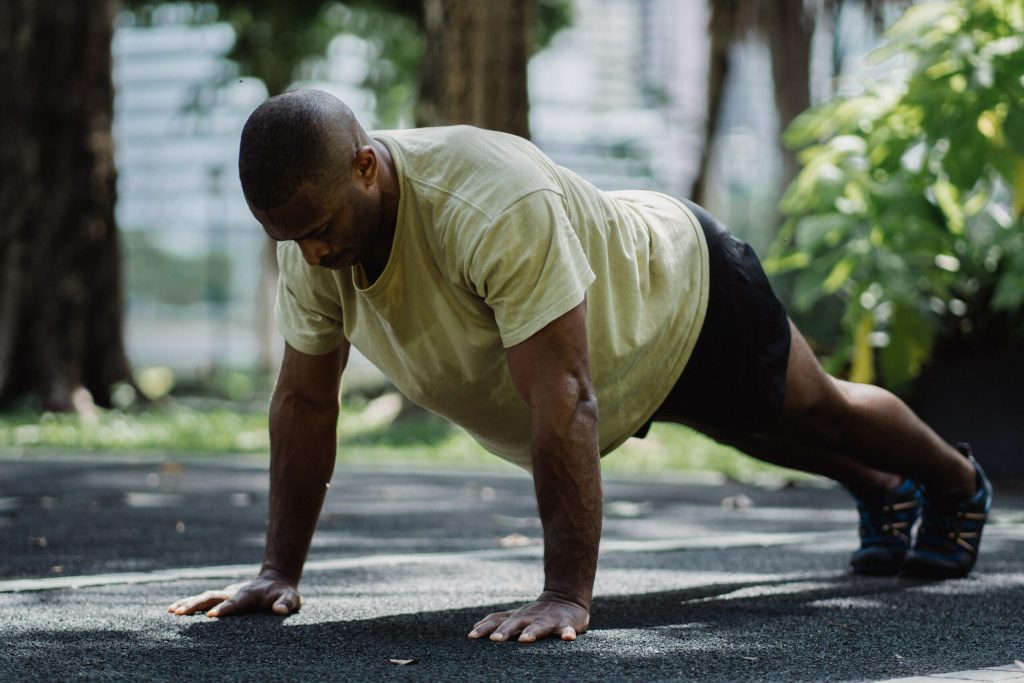Push-ups are an exercise that can be performed anywhere, or anytime, but it is essential to first understand the ins and outs of the entire movement.
The push-up is an essential movement to improve upper body strength, develop and tone correlating musculature, and improve physical performance/function. Becoming proficient with this movement can be significant to enhancing fitness abilities.
The Muscles Worked With Push-Ups
Push-ups focus primarily on the following muscle groups:
- Pectorals (chest muscles)
- Deltoids (shoulder muscles)
- Serratus anterior, trapezius, and rotator cuff (posture and shoulder support muscles)
- Triceps (backside of the arm muscles)
- Core stabilizers (abdominals and spinal support muscles)
- Gluteals (hip muscles)
Being unaware of a movement’s specific anatomy could significantly hinder results or even add to potential injury risk. Using the specific muscles that will be activated in the movement and keeping attention on them is vital to progressing neuromuscular control (mind and body connection).
In order to obtain the best outcome of performing any exercise, our brain and nerves need to deliver adequate signals to the proper muscles to get them to activate in a meaningful manner. Difficulty with flexibility and mobility, poor posture, or prior/active injuries could pose a challenge to perform push-ups efficiently.
Are Push-Ups for Me?
The wonderful aspect of push-ups is that with proper guidance, push-ups can be done by practically anyone. Yes, people just beginning a fitness routine with no prior experience, all the way to a seasoned athlete can yield significant benefit from incorporating the push-up.
Although the push-up is usually considered a movement that works only our upper-bodies, depending on which variation is used, a push-up can actually be very effective at targeting our core and lower body musculature as well. In fact, the push-up has the potential to engage and work our entire kinetic chain! As with any movement, focusing on form and technique will be essential to achieve optimal benefits and reduce the risk of pain and/or injury.
How to Set up a Correct Standard Push-Up:
- Hands should be at chest level and be slightly outside shoulder width.
- Feet should be hip-width apart and parallel to each other—not turned inward or outward.
- Hips should be in line with the shoulders, and the lower back should have a neutral curve—not completely flat, but not overly curved either. To assist with keeping proper lower back alignment, slim your waistline by trying to pull your belly button in and tightening your abdominal muscles.
- The head should be positioned so the ears are in line with the shoulders. They should not drop down toward the floor* or look up in front of the body.
*You can also do this position on an elevated surface or a wall. Choose your position based on your goals, strength, flexibility, and ability to perform the desired number of repetitions without compensation.
While monitoring your body to ensure the correct setup position is maintained, it’s essential to engage the key muscles before beginning the push-up movement. This process helps facilitate the mind-body connection referenced earlier to the primary muscles/muscle groups used in the push-up.
How to Perform a Standard Push-up With Proper Form
Start:

- Engage the core (belly button to spine and tighten abdominals).
- Squeeze the glutes.
- Keeping pressure through the hands, bend the elbows to lower the chest, hips, and head toward the ground.
Cue:

- Get as close to the floor or wall as possible (nose, chest and belly button should be at the same level/height).
- Continue to squeeze the glutes and engage the core.
- Keep constant pressure through the hands into the floor.
Finish:
- Engage the pectorals and imagine you’re pushing the ground away from you.
- Keep your energy focused in your core and NOT in your toes.
- Continue to push up until you’ve returned to the starting position.
Quick Tip and Review: The Five Kinetic Chain Checkpoints
Let’s review proper push-up techniques. When performing a standard push-up, whether performed with hands on an elevated surface or from the floor, it’s paramount to begin the set up with correct form and positioning considering the five kinetic chain checkpoints.
How to Improve Your Push-Ups
A good way to vastly improve or even increase how many push-ups you can do, would be to use a time ratio of 4 seconds : 2 seconds : 1 second. Relating to the push-up, this time ratio setup would be applied by taking 4 seconds to lower your body to the floor or surface, pausing for 2 seconds in the “hover” or bottom position (joint stability), and pushing up as strong and as fast as you can for 1 second.
Varying the time or speed of movement during exercises plays an essential role in how your body responds to your training. Longer time ratios force us to drastically slow down and move with specific intention while also increasing the time our muscles are kept under tension.
Implementing this practice also provides the benefit of improving connective tissue strength, muscle development, muscular endurance, as well as further bodily control/awareness. Practicing this is not easy by any means; however, performing push-ups with proper technique will ensure your muscles and joints are prepared for future progressions.
The key to progressing the pushup is establishing an appropriate starting point for you to perform a standard push-up, while maintaining proper form, body alignment, and tempo.
Due to the tremendous changes in how we, as a society, live, work, and play, it’s likely that a lot of people have some limitations/alterations in body alignment and muscle balance that will make it more difficult to exercise and move without compensations. Given this, it is important to recognize your strength and movement capabilities. More importantly, acknowledging your current limitations will help determine what types of push-ups you should start with. When choosing what style of push-up(s) to include in your routine, you must select the option(s) that best complement your lifestyle, desires, and movement tendencies to ensure you not only get to your goal but do so pain and/or injury-free. Your Exercise Specialist can help you with all of the above and more, so please reach out if you need assistance or have any questions or concerns.



